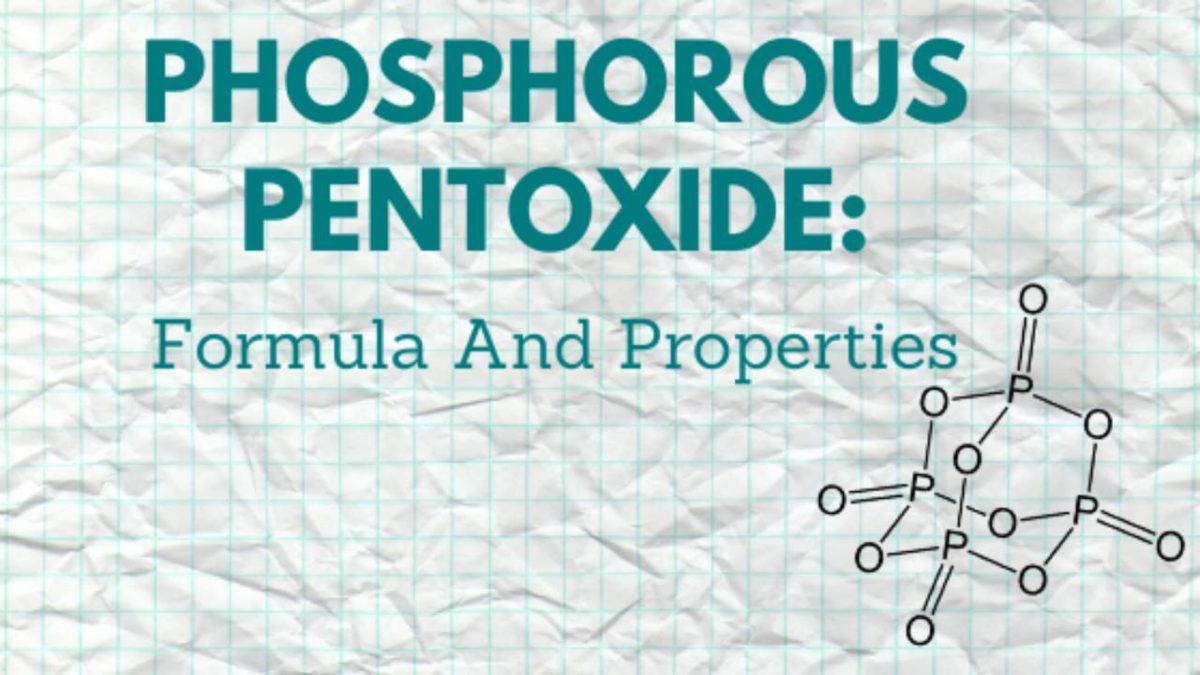Table of Contents
What is P4O10 (Phosphorus Pentoxide)?
P4O10 (Phosphorus pentoxide) is the generic name for a covalent compound consisting of 4 phosphorus (P) and 10 oxygen (O) atoms.
And also, It is sometimes called diphosphorus pentoxide, phosphorus pentoxide, and Tetraphosphorus dioxide.
Phosphorus pentoxide takes its name from the empirical formula of the mix – P2O5. P2O5 molecules are unstable and combine to form larger P4O10 molecules.
The name may be confusing to some, as the prefix “pent-” refers to five and 10 oxygen atoms in the compound.
“Without phosphorus, there would be no thoughts.”
- Phosphorus pentoxide is a white, waxy solid at room temperature with 4 distinct crystal structures.
- It is phosphoric acid anhydride and is highly hygroscopic, which means it quickly absorbs water from the surrounding atmosphere.
- Thus, phosphorus pentoxide is a desiccant to keep places dry and free of airborne moisture.
- During storage, phosphorus pentoxide reacts with the atmosphere to form a phosphoric acid layer around the compound.
- This acidic layer can prevent phosphorus pentoxide from extracting water from the air, making it less effective as a desiccant.
- Phosphorus pentoxide is usually in granular form for use in desiccants.
- Historically, phosphorus pentoxide was created by a reaction with white phosphorus and oxygen, but other, more efficient production methods have replaced it.
Physical properties of P4O10
- At room temperature, phosphorus pentoxide is a waxy white solid and is usually a powder.
- The molecule has a hexagonal figure. This compound is exclusive in that it exists in four different polymorphic forms.
- Most often, there are two P2O5 molecules linked together to form the larger P4O10.
- All polymorphs of phosphorus pentoxide has the tetrahedral arrangement of the phosphorus and oxygen atoms that make up the compound.
- It melts at 340 ° C and boils at 360 ° C. Because the melting and boiling points are so close to each other, phosphorus pentoxide often skips melting and sublimates from stable to solid. A gas.
What is the chemical name for P4O10?
- There are 2 types of chemical formulas in chemistry: molecular formula and empirical formula.
- Both are atomic constituents of a given compound but in different ways. The molecular formula tells you the type and number of atoms in a single molecule in a mixture.
- The empirical formula means the simplest integer ratio of elements in a mix.
- The 2 compounds can have the same molecular formulas and the same empirical formula, such as acetylene (C2H2) and benzene (C6H6), both of which have the empirical formula CH.
- Likewise, the empirical formula for ethylene (C2H4) and butane (C4H8) is CH2.
- The molecular method of a compound is either equal to its empirical formula or is an integer multiple thereof.
- Sometimes the common name of a compound comes from its empirical formula rather than its molecular formula.
- It is the case with phosphorus dioxide. Phosphorus pentoxide has the molecular formula P4O10, and therefore the empirical formula P2O5.
- The “pentoxide” in “pentoxide” comes from the empirical formula P2O5.
- In phosphorus pentoxide, molecules with the formula P2O5 will bind to form larger P4O10 molecules.
- The molecular formula of phosphorus pentoxide is P4O10.
- It is still called phosphorus pentoxide because of its empirical formula P2O5.
- Phosphorus pentoxide is unique in that it can exist in up to 4 different polymorphs.
- The most common form is a single P4O10 molecule formed by stacking two smaller P2O5 molecules together.
- P2O5 has a volatile molecular configuration, so two molecules will combine into one large molecule of P4O10,
Chemical name of P4O10?
- P4O10 is a P2O5 dimer, whose chemical name is phosphorus (V) oxide.
- Phosphorus Pentoxide is a Chemical compound through the molecular formula P₄O₁₀.
- This white crystalline solid is phosphoric anhydride. It is a powerful drying and dehydrating agent.
- P4O10 (Tetraphosphorus dioxide), but under normal conditions, it only exists as a dimer P2O5, phosphorus (V) oxide, or phosphorus pentoxide.
Chemical properties of P4O10
- Phosphorus pentoxide is a polar compound. It is non-flammable, which means it does not react with oxygen to form a flame.
- However, it is very volatile with water and forms phosphoric acid.
- It can cause a fire if it arises in contact with materials containing water such as cotton or wood.
- In contact with metal, it is corrosive and forms various metal oxides. It also corrodes the skin and other tissues, causing chemical burns and inflammation of the airways.
- These irritations and injuries occur even at low concentrations. Appropriate protection precautions should be observed when handling phosphorus pentoxide.
Other names for P4O10
Although phosphorus pentoxide is the most common name for P4O10, it also has other words, including:
- Diphosphorus pentoxide
- Phosphorus oxide (V) Phosphorus anhydride
- Tetraphosphorus decaoxide
- Tetraphosphorus dioxide
- KNOW MORE:- smartmores

